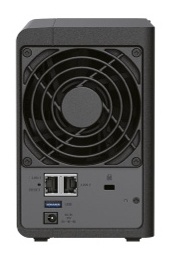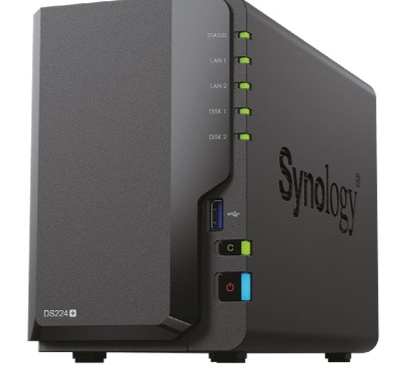Why you can trust TechRadar
This review first appeared in issue 358 of PC Pro.
At first glance Synology’s DiskStation DS224+ looks much like the cheaper DiskStation DS223. It’s the same color and dimensions, and has the same button, port and LED layout on the front panel. Snoop around a bit and you’ll spot a significant improvement, though: this NAS has dual 1GbE ports, which can be used to offer faster throughput and failover support.
There’s a bigger upgrade inside, where the DS224+ has an Intel Celeron J4125 processor rather than the limp Realtek in the DS223. Its 2GB of memory is also upgradable to 6GB via a spare slot, accessible without tools if you remove the drive caddies. Synology talks up the enhanced performance of the DS224+ when compared to previous-generation devices, and this processor should certainly help if you’re intending to use it as a media server in the home.
It’s usually easy to set up Synology devices, and the DS224+ obliges with tool-free caddies for 3.5in SATA drives – as with other contenders here, you’ll need to screw in 2.5in disks. You can quickly track down any local DiskStations via the Web Assistant. Once you’re into the web interface, it’s simple to install Synology’s DSM software and configure the storage.

We added two 4TB disks provided by Synology, configuring them in a RAID1 array and formatting them with Btrfs; EXT4 is available if needed. The DS224+ delivered on its improved specifications, outpacing the DS223 in 4KB and 16KB file operations in ATTO Disk Benchmark. It was also a little quicker to write files in our Windows file copy test, hitting 60MB/sec compared to 52MB/sec for the DS223.
This is something of a distraction from the fact that this NAS is throttled by its gigabit Ethernet ports. In our tests it sustained a maximum transfer speed of 113MB/sec. In comparison, 2.5GbE connections can deliver up to 283MB/sec. It’s easy to bond the two network interfaces, but this won’t improve speeds to a single client; instead it helps increase bandwidth when there are multiple users.
Synology pitches this NAS as a data storage device for edge deployments, which is likely to mean home workers and micro offices. Synology’s software is certainly more than equal to the role, combining a solid feature set with 107 apps available through Package Center. Perhaps this NAS’s slower Ethernet won’t be a problem for home workers primarily connecting via Wi-Fi, but if you have several users we’d recommend paying more for an alternative with a 2.5GbE interface.
Simon Handby is a freelance journalist, writer and editor at Hackbash with over two decades of experience in the technology, automotive, and energy sectors.
What is a hands on review?
Hands on reviews' are a journalist's first impressions of a piece of kit based on spending some time with it. It may be just a few moments, or a few hours. The important thing is we have been able to play with it ourselves and can give you some sense of what it's like to use, even if it's only an embryonic view. For more information, see TechRadar's Reviews Guarantee.

